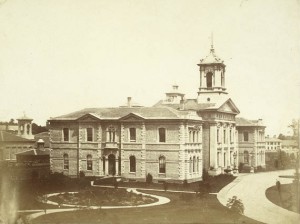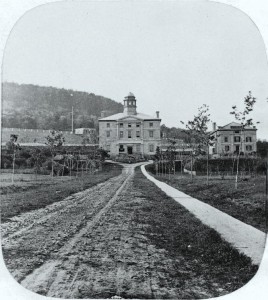10.9 Education
Formal education has a complicated history in Canada. Loyalists and other American immigrants brought with them a stronger tradition of education than what existed in New France (outside of the main towns), which much of British North America inherited. This was evident in the West during the first two decades of the 19th century when the HBC established schools at Red River for the mixed-blood offspring of its employees and when North West Company men lobbied for a school at Fort William or Rainy Lake for the education of their métis children. A basic education was regarded by these men as a critical and fair demand; they valued fundamental reading and writing skills in particular.[1]
Parochial, Private, Public
In contrast, illiteracy was the norm in rural Lower Canada. Many Canadiens saw little value in formal education. Farm life was trying, subsistence farming even more so, and all hands were required to work. Even children worked at farm labour from a very young age.
In 1846 the united Province of Canada passed the Common School Act, which took education out of private hands for the most part, but the legislation had little impact in smaller, poorer districts. The law called for a tax assessment on residents to cover school construction, and the execution of the policy was to be guided by locally elected school commissioners. Poor farmers greeted the new levy with resentment and the commissions attracted the few literate residents in a community, individuals who weren’t always typical of the larger population. Suspicion of education as a tool for assimilation of French speakers by the dominant English regime was rampant (and, in Lower Canada in the aftermath of the Durham Report, that was a reasonable response).[2]
In the growing towns of the Canadas, formal education remained something only a minority enjoyed at mid-century. In Hamilton, for example, it is estimated that barely half the population between the ages of 5 and 16 attended school. The share only crept above 40% between the ages of 7 and 13.[3] Education could, of course, be delivered by private tutors in the homes of the better-off citizens, and being schooled abroad was an option for the children of the elites. Throughout the 19th century, the children of the more senior HBC traders and their Aboriginal wives were often sent to Britain for their education.
Educational Reform
The rise of widespread, publicly supported schooling in mid-century was one more expression of a growing democratic sentiment, one that linked education to individual accomplishment and social improvement. A better educated society was better equipped to handle democratic responsibilities and promised to be more economically dynamic. As well, it was believed that schooling could address in some measure the perceived problems associated with unemployed, disruptive, perhaps criminal, and possibly pauper children on the streets of the growing towns and cities. In the same way, too, public schooling was wielded as a weapon against social disorder that might follow in the wake of immigration. These motivations reflect a particular urban, Anglo-Saxon, and moralistic perspective on both childhood and Irish immigration.
Not everyone subscribed to the view that either concern was significant, but enough did together that they shaped the language and legislation around schools.[4] That said, what education most boys in British North America received prior to mid-century was informal and limited. “Sunday schools” became highly popular in England in the 18th century and soon spread to British North America: these were the only educational venues many boys and girls would ever see, despite the changing views in support of formal learning.

In the 1840s growing interest in a common project of secular education raised questions about teacher training. Normal schools began to appear across the colonies and the colonial administrations began to take an active role in developing curriculum and education systems. This process should be viewed in the context of the broader ethos of reform as it was emerging in the mid-century. As we shall see in Chapter 11, reform took a particular shape when it came to formal politics, but more generally it called for the betterment of a broader slice of society. Old social relations were being tested. Demands were rising for greater opportunities to improve those things thought to be essential to personal achievement. Education certainly fell into this category. But, as historian and social scientist Bruce Curtis has indicated, it was a potentially divisive if not explosive issue:
Educational reform … was inextricably connected to questions of the form of the colonial state. All the fundamental questions concerning educational organization — who needed to be taught, who could educate them, what they needed to know, how they should learn it, who should pay for it — these and other questions were answered only by answering at the same time questions concerning the state: who would rule, how, of what would rule consist, how would it be financed. The struggle over education was at once a struggle over political rule.[5]
Tories, of course, wanted an education system that taught deference and loyalty. Reformers preferred a locally controlled model headed by school trustees elected by parents, and it was this model that succeeded and thrived across British North America. Its purposes were different from colony to colony, but at its heart it sought to create a commonality of experience and thus a citizenship. As Curtis points out, this kind of policy-making wasn’t imposed on the public: it “constructed a public.” It had a strong moral undercurrent that resonated with Protestants, elements of deference to authority that appealed to Tories, and a step toward universality that spoke to Reformers. The state, as Curtis indicates, was in the process of making civil society.
Colleges and Universities
Higher education expanded dramatically in these years. Before 1818 there existed, in addition to the Séminaire de Québec (later Laval University), only the University of New Brunswick and King’s College (established first in Windsor, Nova Scotia, and then moved to Halifax). Over the next 40 years, several more institutions were established, of which nine were full universities from the start. Nearly all of them were initially associated with a single denomination:
- Catholic: Laval, St. Mary’s, Ottawa, Saint Francis Xavier, Windsor College (much later the University of Windsor), and Collège de Saint-Boniface (very recently renamed the Université de Saint-Boniface)
- Church of England: King’s College (in Halifax), UNB, King’s College (later the University of Toronto), and Bishop’s University
- Baptist: Acadia
- Methodist: Mount Allison
- Presbyterian: Queen’s
Only two universities in this period, McGill and Dalhousie, were non-sectarian or non-denominational, although in the case of McGill, an English-language institution in a largely francophone city, “non-denominational” may be read as “Protestant.” Half of this list comes from Nova Scotia and New Brunswick, where denominationalism was a powerful force in the 19th century, one that had a significant claim on a person’s identity and opportunities.

These early universities emphasized the liberal arts and theology as fields of study. Mathematics was a speciality at the Séminaire de Québec from the days of New France. Some, including Queen’s and Dalhousie, modelled themselves on the Scottish universities where sciences were a key part of the curriculum. However tolerant they might be in terms of denominationalism, the Protestant universities in particular were finishing schools for the colonial elite. These were not institutions designed to advance the opportunities of the common man and particularly not the common woman. The Catholic institutions were, of course, training centres that prepared seminarians for careers in the Catholic establishment: clerics, nuns, social workers, and teachers alike all came out of the Séminaire de Québec, for example.
Key Points
- Formal education was transitioning in the mid-19th century from being run by the clergy or offered privately by untrained women or men to being increasingly standardized and professionalized.
- Educational reforms reflected changing social values, which included growing support for widespread literacy.
Attributions
Figure 10.10
Normal School on Gould Street by Finavon is in the public domain.
Figure 10.11
McGill College, Sherbrooke Street, Montreal, QC, about 1859 by Jeangagnon is in the public domain.
- Jennifer S.H. Brown, “Children of the Early Fur Trades,” in Childhood and Family in Canadian History, ed. Joy Parr (Toronto: McClelland and Stewart, 1982), 57. ↵
- Cole Harris, "Of Poverty and Helplessness in Petite-Nation," Canadian Historical Review 52, issue 1 (March 1971): 23-50. ↵
- Michael B. Katz, The People of Hamilton, Canada West: Family and Class in a Mid-Nineteenth-Century City (Cambridge, Mass.: Harvard University Press, 1975), 38. ↵
- Chad Gaffield, “Children, Schooling, and Family Reproduction in Nineteenth-Century Ontario,” Canadian Historical Review 72, no.2 (June 1991): 157-191. ↵
- Bruce Curtis, "Preconditions of the Canadian State: Educational Reform and the Construction of a Public in Upper Canada, 1837-1846," in Age of Transition: Readings in Canadian Social History, 1800-1900, ed. Norman Knowles (Toronto: Harcourt Brace, 1998), 246. ↵

